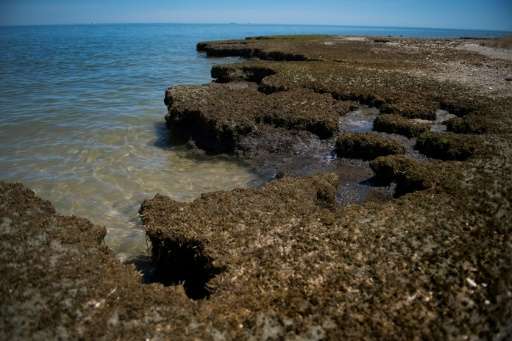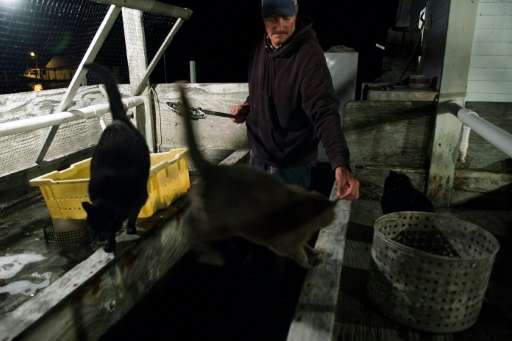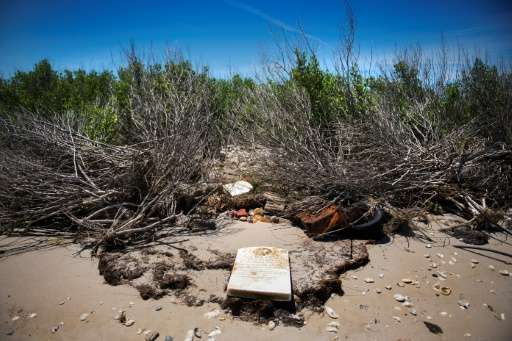Off US coast, Tangier Island disappearing under water

On Virginia's Tangier Island, about 100 miles and a ferry ride from Washington, the waters of the Chesapeake Bay are edging dangerously close to William Eskridge's house.
Eskridge's family has lived here for the last 200 years. But perhaps not for much longer. The island is under threat from rapid erosion that is being accelerated by rising water scientists believe to be caused by climate change.
At least a hundred feet of land have recently eroded, the fisherman says.
"And it just seems like it's getting worse every year. I'm kind of fearful what it's going to be down the road."
Tangier Island is wedged between the eastern shore of Maryland and the Virginia coast.
Now measuring just 1.2 square miles, it has lost two-thirds of its landmass since 1850. If nothing is done to stop the erosion, it may disappear completely in the next 40 years.
The 450 or so inhabitants here—most of whose families have lived here for several generations—are keen to save their island, classified in the National Register of Historic Places.
Carol Pruitt Moore, who belongs to one of the island's old fishing families, remembers going to the beach as a child. Back then, the walk would take an hour. Now it takes only 10 minutes.
"Not to save Tangier," she says, would be "a tragedy."
Nevertheless, many residents support the rhetoric of President Donald Trump, who on Thursday announced the US withdrawal from the Paris climate accord.
The Republican billionaire, who has argued that environmental regulations are damaging for the US economy, won 87 percent of the vote in Tangier, where many don't believe the evidence that climate change is man-made.

"It has nothing to do with sea-level rise," a retired teacher who gave his name as Bruce says about the island's woes.
"I'm sure it will impact us in time, but we're talking about short-term erosion, which has been going on for decades."
Saving the harbor
Tangier Mayor James Eskridge—William's brother—is pushing for the construction of a new sea wall to protect the town's main harbor.
The harbor—a lifeline for the families making a living off the crab fishing industry—is directly threatened by erosion. Its western entrance is growing wider as the water rises, making it increasingly vulnerable during storms.
But seeing the project become a reality has been painstakingly slow.
"This project here has been in the works for, I would say, almost 20 years," Eskridge said. "And since then, in 20 years' time, there's been so much erosion going on here that the original project would not work now."
The delays are frustrating Tangier's residents as the erosion visibly diminishes their island.
Now set to be completed by next year, the project will provide only a short-term band-aid for a much bigger problem.
'Sunken sand hill' at risk
David Schulte walks on what was once the village of Canaan. Today, only a few gravestones on a beach remain. Abandoned in the 1930s, Canaan is a reminder that erosion has always been a problem on Tangier Island.

But Schulte—a marine biologist with the United States Army Corps of Engineers—says global warming is dangerously accelerating that phenomenon.
"The water is now high enough that it's striking above the sand line on the island," he says.
Tangier is particularly vulnerable because it's made of softer material than many other islands.
"The island is basically a sunken sand hill, it's not like the islands on the South Pacific that have more stone," Schulte says, adding that a peat marsh on top of the sand is "very soft organic clay soil."
"Once the water gets high enough to hit the peak directly, it's just tearing the island to pieces."
Saving the island in the long term would require constructing additional sea walls and bailing out water from the island's center, he says.
"We go offshore, we get some sandy material with a big dredge and we pump it on top of these present ridges and physically build up the land."
However, any such engineering plan would depend on Congress, which must approve a new study to determine what measures can be taken to save the island.
Lawmakers would then have to vote to finance the project, estimated at a cost of tens of millions of dollars.
Timing is also crucial. Virginia Marine Resources Commissioner John Bull says that if a decision to go ahead is to be made, it must be done quickly.
"The environmental changes we've been seeing indicate that at some point, it will be too late to save Tangier," Bull warned.
© 2017 AFP



















